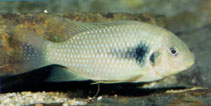| Diagnosis: |
Dorsal spines (total): 15-15; Dorsal soft rays (total): 10-10; Anal spines: 3-3; Anal soft rays: 7-8; Vertebrae: 25-25. Diagnosis: 2 supraneural bones; scaleless, darkly pigmented blotch on dorsocaudal field of opercle; cuspidate oral jaw dentition; some or all teeth tricuspid in outer row oral dentition (Ref. 49597, 52307). Upper lip with crease (Ref. 49597). Spinous dorsal fin deeply excavated dorsally (Ref. 49597, 52307). Strongly marked oblique black bar anterior on body in preserved specimens; mouth small and slightly inferior (Ref. 49597).
Description: medium-sized, deep-bodied (43.2-48.0% SL) (Ref. 49597, 81260). Predorsal profile smoothly convex and rising to greatest body depth at dorsal fin origin (Ref. 49597, 52307, 81260). Belly somewhat rounded (Ref. 49597). Caudal peduncle short and deep; mouth small, slightly inferior with procumbent lower jaw teeth exposed above thin lower lip and wide isthmus; thick upper lip with deep crease on lateral face (Ref. 49597, 81260). Lower pharyngeal jaw small, relatively robust and slightly wider than long; neurocranial apophysis for upper pharyngeal jaws formed of parasphenoid alone (Tilapia type)(Ref. 49597). Outer row jaw teeth robust, slightly spatulate, tricuspids becoming mainly bicuspid in specimens > 50mm SL, but 2-5 tricuspid teeth retained in posterior field of upper jaw even in largest individuals; no visor-like pad on roof of pharynx (Ref. 81260). 2 supraneural bones (Ref. 49597, 52307). Closely set gill-rakers along lower limb of first arch, becoming progressively elongate and slender towards angle of arch, and directed oblique forward across arch surface; 2-3 bulbous fleshy papillae medially between outer and inner rakers (Ref. 49597). Microbranchiospines present on outer face of 2nd, 3th and 4th gill arches (Ref. 49597, 81260). Scales imbricate and cycloid; 2-3 scale rows on cheek; 4 scale rows between upper lateral line and dorsal fin origin; 4-5 scale rows between pectoral and pelvic fins; lower lateral line reaches end of upper, not beyond; caudal fin scaled only at base (Ref. 49597). Length of spinous rays of dorsal fin increases steeply to 4th then decreases gradually to 14th, 15th spine markedly longer than 14th (Ref. 49597, 81260) resulting in a strongly excavated dorsal margin to spinous dorsal (Ref. 81260). Posterior rays of anal and dorsal fins produced in mature males, extending over peduncle to base of caudal fin; pectoral fins not reaching level of anus (Ref. 49597). First soft ray of pelvic fin elongate and filamentous extending over spinous anal (Ref. 49597, 81260) in adults of both sex (Ref. 81260). Caudal fin moderately truncate (Ref. 52307). Gut tightly coiled (Ref. 49597).
Coloration: in life: body pale yellow-gold, snout and nape slightly darker light brown, belly paler yellow; each body scale with iridescent turquoise blue spot enclosing a central creamy yellow fleck, resulting in a series of iridescent longitudinal bands; iris yellow-gold with slight iridescent turquoise hue (Ref. 49597, 81260). Scaleless black-brown spot in posteriocaudal field of opercle (Ref. 49597, 52307, 81260). Strongly marked elongate dark black-brown blotch behind pectoral fin at mid-flank; blotch extending posteriorly along anterior midline of flank or dorsally as an oblique bar, depending on emotional state (Ref. 49597, 81260). Throat and pelvic fins may turn black in some individuals/situations; some dark bars may be present on body (Ref. 52307). Fins clear hyaline with numerous small turquoise spots on soft dorsal and anal fins (Ref. 49597, 52307, 81260), and on median field of caudal fin (Ref. 49597, 81260). Preserved specimens: base color uniformly pale yellow-brown; snout, nape and dorsum slightly darker brown, belly pale creamy brown; scaleless black-brown spot in posteriocaudal field of opercle; strongly marked black-brown oblique bar anterior on body, passing from level of upper lateral line just anterior to dorsal fin origin, obliquely behind pectoral fin to mid-flank; 3 faint vertical stripes on posterior half of body passing from dorsum to just below level of lower lateral line; faint longitudinal band passing along mid body to origin of caudal fin; fins clearly hyaline, with traces of spotting on posterior soft dorsal (Ref. 49597). |
| Biology: |
Juveniles were collected with beach seine in the shallow inshore zone in a water depth of few centimeters, adults in deeper water; juveniles prefer shallow water riffles with medium current, while adults congregate around submerged tree branches and rocky outcrops (Ref. 49597). Mainly feeds on detritus, occasionally on insects and plants (Ref. 52307). Delayed uptake, ovophilic (Ref. 81260), larvophilic (Ref. 52307) mouthbrooder (Ref. 52307, 81260) that does not pair-bond (Ref. 52307), spawning in couples over open substrate (Ref. 49597). Female (rarely the male) incubates the fry (Ref. 49597, 52307). |

